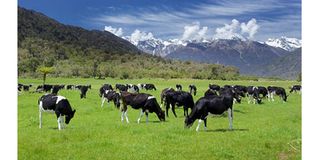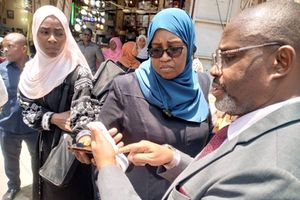Unlocking feedlot potential to shape Tanzania's cattle farming

There is an increasing demand of forage in the country. PHOTO | COURTESY
What you need to know:
- It is said that in Tanzania, local farmers keep the indigenous Zebu and Ankole breeds, but Zeb’s share dominates the population as it accounts for 95 percent of the country’s 35.9 million cattle.
Dar es Salaam. Tanzania’s cattle farmers ought to adopt the feedlot system to increase income and narrow the country’s beef production and consumption balance, which currently stands at 124,778 tons, equal to an annual 17 percent deficit.
The expected supply gap is said to be driven by inadequate animal genetics, health, and feed barriers, resulting in the beef cattle industry’s low contribution to the national economy (only 5.9 percent of GDP).
A recently published study dubbed ‘Feedlot Performance and Profitability on Local Resources,’ indicates that cattle fattening is one of the methods for value addition of indigenous breeds that can be used to improve carcass weight and meat quality for domestic and foreign markets.
The study was conducted by Mr Saning’o Kimirei, Mr Sebastian Chenyambuga, and Ms Zena Mpenda, from Sokoine University of Agriculture (SUA). Others are Mr Daniel Mushi and Mr George Msalya from Tanzania Meat Board (TMB) and Tanzania Dairy Board (TDB), respectively.
It is said that in Tanzania, local farmers keep the indigenous Zebu and Ankole breeds, but Zeb’s share dominates the population as it accounts for 95 percent of the country’s 35.9 million cattle. Moreover, the breeds altogether, produce about 98 percent of the beef consumed in the country.
The journal explains that indigenous cattle are herded continuously on the available natural pastures on communal grazing lands during the dry and wet seasons, thus producing low-quality and inefficient beef.
According to Food and Agriculture Organisation (FAO) statistics, per capita meat consumption in the country is estimated to be 12 kg, which, according to international standards, is below the recommended 50 kg.
On the other hand, TMB data indicates that Tanzania’s meat exports rose by 57 percent in August 2022 due to a rise in demand for meat in foreign countries, an opportunity livestock keepers should consider grabbing.
“Feeding rations with high energy content can improve the growth performance of beef cattle and reduce the time spent in the feedlot. Maize grains and molasses are the main supplements used to provide energy to cattle under the feedlot system,” the journal reads in part.
It adds: “However, these energy concentrates are expensive due to their high demand for use in other livestock, especially poultry and pig diets, thus limiting their availability, and most traditional feedlot operators cannot afford to use them for cattle fattening.”
Therefore, the study argues that traditional feedlots, in which the operators use rice polishing and maize bran as the sources of energy in fattening diets, is a profitable entity that one can adopt as the said energy sources are cheap compared to maize grains and molasses.
According to the report, if farmers decide to adopt a feedlot system, using traditional resources, then it is projected that Zeb bulls that are fed by supplemented concentrate diets will grow faster and attain slaughter weight in a shorter time compared to those under grazing only.
The report also indicates that for this to happen, local farmers should feed their cattle maize bran, rice polishing, and molasses for energy, and sunflower seed cake for protein.
The combined balanced diets are said to support higher growth performance and a better feed conversion ratio of indigenous beef cattle in feedlot systems, as well as a reduction in operational costs and a large profit for the farmer.
Mr Maduhu Ntemi, a feedlot operator in Simiyu, says: “I had about 50 plus indigenous cows that I traditionally kept for about ten years. They gave us milk except during dry seasons.”
The father of five told this paper that whenever a need for money arose, he would sell one of his weak animals so as to cater for the said need, though later on, he considered shifting to semi-commercial cattle farming.
“I sold about ten healthy animals, which yielded at least Sh3.5 million; I invested the money into a feedlot. Commercial feeds are very expensive, so a friend advised me to source locally available materials. With his guidance, I started fattening some of my cows,” he recalls.
He adds: “Life has changed due to increased income. In fact, since I adopted the feedlot system, I now sell one cow for more than what I got after selling my ten cows. Of course, I still practice traditional grazing, but prior to selling, I usually get them into the feedlot to fatten them.”
Data from the Pugu livestock market located in the Dar es Salaam suburbs indicates that for the week ending September 23, 2022, cattle weighing 550 kg, fetched Sh1.9 million, a 10 percent increase from what was recorded in the previous week.
To keep his cattle healthy as they enter the feedlot, Mr Ntemi explains that he often limits the feed for a brief time to allow the animal to adjust to the feedlot diet, after which he continues with appropriate feeding intakes to maintain a constant body size.
“I believe it is a good business. Of course, you will need an initial capital, and for the livestock keepers, it is easy. You just need to sell some of your cows, it is unprofitable to keep a large group of cows yet with zero benefit,” he observes.
“Apart from social and cultural events, one cannot slaughter his cow to simply reward themselves for the challenging work of keeping them. Of course, you will consume milk because in the village setting, it is difficult to sell cows, as almost every household owns one.”
He says: “People eat meat, and if you want to get maximum profit, then feedlots are the area one should consider investing in. These days, we don’t sell animals just by the look or estimation; we sell by weight, and fattening is the way to go.”
His views are supported by Mr Cornel Kibona, Mr Zhang Yuejie, and Mr Lu Tian from Jilin Agricultural University in China,
In their study on factors that influence meat production in Tanzania, the researchers think more commercial feedlots are needed to respond to the increased demand for high-quality meat proteins.
According to the trio, in Tanzania, 94 percent of the total beef cattle herds are predominantly produced using traditional beef cattle farming (a free-range production system), while only 6 percent are produced using commercial (modern) beef cattle farming.
Although the live weight considered acceptable for slaughter cattle is determined by market demand, animals can be fed in many ways to obtain a heavier carcass with the correct amount of fat within and over muscle.
It is said that the country’s Zeb mature body weighs between 200 and 350 kg, while for the Ankole, it is between 500 and 730 kg).
Therefore, in order for Tanzania to increase the value of its beef production, the study suggests that the government needs to develop effective action plans and industry support policies to promote beef cattle quality, yield, and productivity.
Moreover, such policies should focus on creating incentives for farmers to participate in the market, which promotes beef cattle supply in the market (increased beef cattle extraction rate), resulting in increased beef meat production.
Furthermore, according to the journal, “emphasizing proper use of farm credit (invested credit in agriculture) by providing farmers with suitable and convenient credit-securing arrangements will add value to the beef cattle business, thereby increasing meat production.”
Pepita Mwanga’s bilingual (Swahili and English) poem was a fitting tribute to Mwalimu and informative entertainment for the day.




